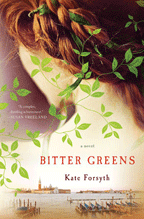Exclusive interview with author Kate Forsyth and a review of her tale of Rapunzel, told from the perspective of that story’s author Charlotte-Rose de la Force
Rating: 3 Stars
Review by Gabrielle Pantera
“When I was twelve, I read a book called The Stone Cage by the British children’s writer Nicholas Stuart Gray,” says Bitter Greens author Kate Forsyth. “It’s a retelling of Rapunzel told from the point of view of the witch’s cat. I was utterly enchanted by this book, and realized for the first time that writers can retell a tale to give it greater depth and vividness.”
 Forsyth weaves a story within a story and brings the two together in this retelling of Persinette, the story adapted by the Brothers Grimm that became Rapunzel. It is the story of Persinette and the parallel story of Charlotte-Rose, who has been banished from court for indiscreet behavior. She brings the stories together seamlessly. You never lose track of whom you’re reading about. The emotions of Margherita and Charlotte-Rose are palpable and understandable. A story of black magic, romance and love, you will not want to put it down.
Forsyth weaves a story within a story and brings the two together in this retelling of Persinette, the story adapted by the Brothers Grimm that became Rapunzel. It is the story of Persinette and the parallel story of Charlotte-Rose, who has been banished from court for indiscreet behavior. She brings the stories together seamlessly. You never lose track of whom you’re reading about. The emotions of Margherita and Charlotte-Rose are palpable and understandable. A story of black magic, romance and love, you will not want to put it down.
Charlotte-Rose de la Force a relative of the Sun King, Louis XIV. She’s has been banished from the Versailles court and sent to a convent. The old nun Sœur Seraphina tells her a hundred-year-old tale of a young girl who was spirited away from her family for a handful of bitter greens.
Persinette’s father has stolen the parsley from the garden of courtesan Selena Leonelli. Stealing is punishable by having both hands cut off. He’s forced to make a deal with Selena. He must give her their little girl, named Margherita, who Selena renames Persinette. Selena has mastered witchcraft to keep herself young. Imprisoned in a tower, Persinette starts to sing and hopes someone will hear her. One day a young man does. Charlotte-Rose is captivated by the tale and motivated to write.
“I first read the Rapunzel fairy tale when I was a little girl in hospital,” says Forsyth. “I had been savaged by a dog when I was a baby, and among other serious injuries, my left tear duct was destroyed. No one ever thinks much about that tiny piece of flesh in the corner of the eye, but it has an important function. It flushes away dirt and germs from our vulnerable eyes, which are deeply embedded in our brain. Without a tear duct, I spent my childhood in and out of hospital with a series of life-threatening infections and fevers. Rapunzel is a story about a girl locked away from the world against her will, much as I was imprisoned in that cycle of pain and illness. And at the end of the story, Rapunzel weeps when she finds her blinded lover, and her tears fall upon the prince’s eyes and heals him. So the story gave me hope that one day I too would escape and one day I would be healed.”
For research, Forsyth traveled to France and Italy. One of the de la Force family descendants, the Comte de Sabran-Pontevès, gave her a private tour of the Chateau de Cazaneuve, in Gascony, where de la Force had been born. It is one of the oldest chateaux in France and still owned by the same family.
Bitter Greens was shortlisted for the Aurealis Award for Best Fantasy, the Ditmar Award and the Norma K. Hemming Award (for which it received an Honourable Mention). She’s written picture books for the very young, to a collection of poetry, to essays and articles, books of fantasy adventure for children and books of historical fiction for adults.
Forsyth’s next book is the historical novel The Wild Girl, the story of the forbidden romance between Wilhelm Grimm and Dortchen Wild, the young woman who told him many of the fairy tales. Set during the Napoleonic Wars, it releases in the U.S. spring 2015.
Forsyth was born and still lives in Sydney, Australia.
Bitter Greens by Kate Forsyth. Hardcover: 496 pages, Publisher: Thomas Dunne Books (September 23, 2014), Language: English, ISBN: 9781250047533, $25.99
[adrotate group=”8″]
